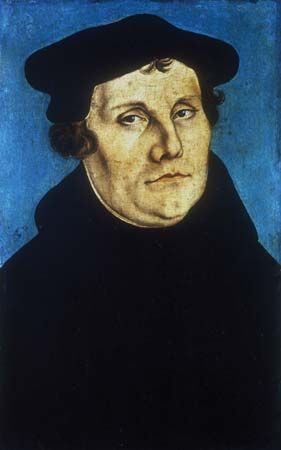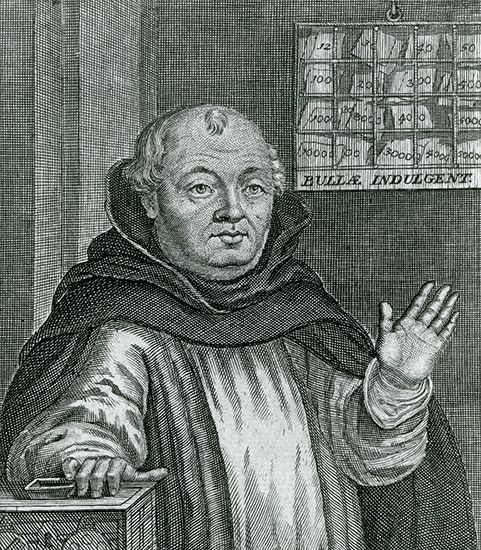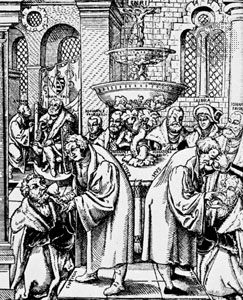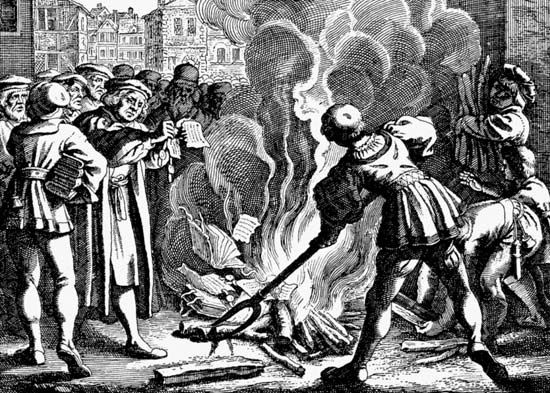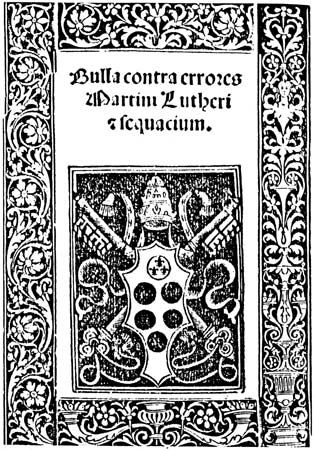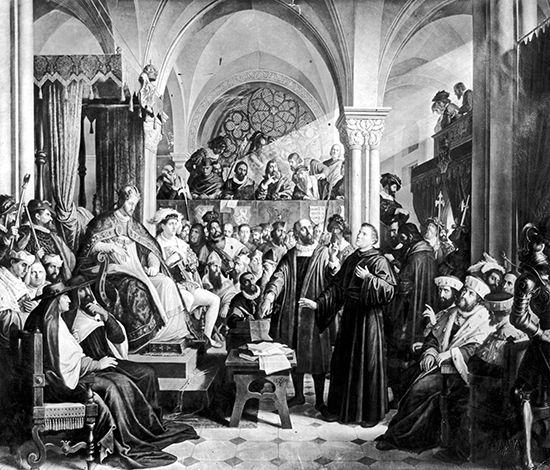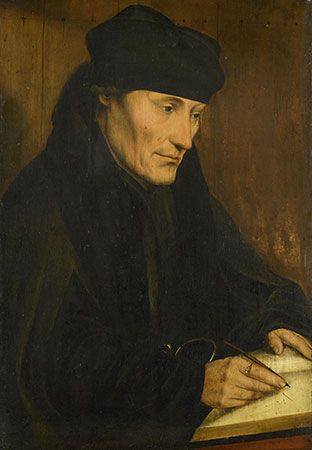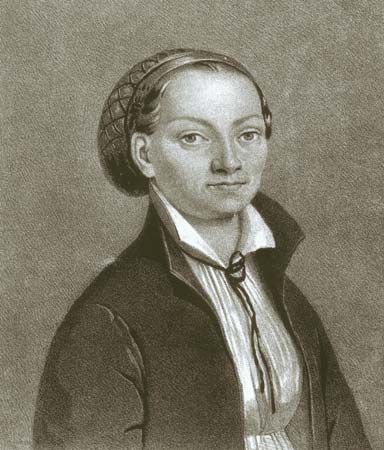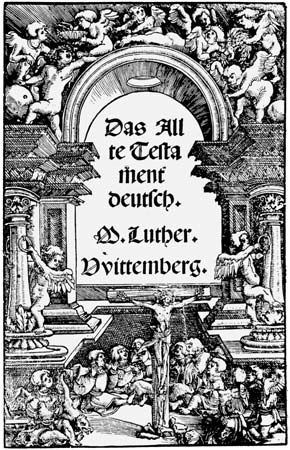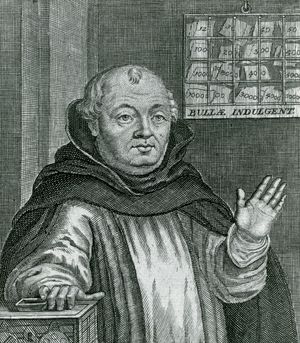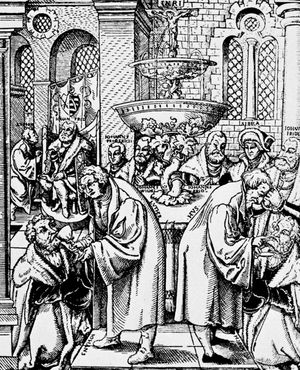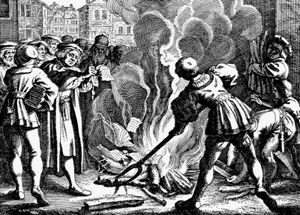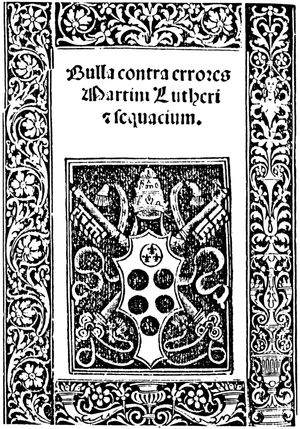The indulgences controversy of Martin Luther
- Died:
- February 18, 1546, Eisleben (aged 62)
- Notable Family Members:
- Son of Hans, copper miner and smelter
- Son of Margaretta
- Brother of 6 or 7 siblings
- Spouse of Katerina von Bora
- Father of six children, four of whom survived to adulthood
- Subjects Of Study:
- Bible
- Lutheranism
- real presence
- authority
- justification
- Role In:
- Colloquy of Marburg
- Reformation
- Education:
- Local Latin school in Mansfeld, Saxony
- Brethren of the Common Life in Magdeburg, starting age 13
- School in Eisenach
- University of Erfurt, 1501
- University of Wittenberg
News •
Indulgences and salvation
In the fall of 1517 an ostensibly innocuous event quickly made Luther’s name a household word in Germany. Irritated by Johann Tetzel, a Dominican friar who was reported to have preached to the faithful that the purchase of a letter of indulgence entailed the forgiveness of sins, Luther drafted a set of propositions for the purpose of conducting an academic debate on indulgences at the university in Wittenberg. He dispatched a copy of the Ninety-five Theses to Tetzel’s superior, Archbishop Albert of Mainz, along with a request that Albert put a stop to Tetzel’s extravagant preaching; he also sent copies to a number of friends. Before long, Albert formally requested that official proceedings be commenced in Rome to ascertain the work’s orthodoxy. Meanwhile, it began to be circulated in Germany, together with some explanatory publications by Luther.
Luther clearly intended the Ninety-five Theses to be subservient to the church and the pope, and their overall tone is accordingly searching rather than doctrinaire. Nevertheless, there is a detectable undercurrent of “reforming” sentiment in the work—expressed in several theses beginning with the phrase “Christians are to be taught that…”—as well as some openly provocative statements. Thesis 86, for example, asks,
Why does not the pope, whose wealth today is greater than the wealth of the richest Crassus, build the basilica of St. Peter with his own money rather than with the money of poor believers?
Scholars have disagreed about how early Luther began to formulate the theological positions that eventually caused him to part ways with the church. If he had done so by the fall of 1517, then the Ninety-five Theses must be viewed as the first—albeit hesitant—manifesto of a new theology. Most scholars, however, believe that Luther’s conversion was a lengthy process that did not culminate until well after the indulgences controversy was in full swing in the spring of 1518. Indeed, his conversion to a new understanding of the gospel was heavily influenced by the controversy, according to this view.
By the end of 1518, according to most scholars, Luther had reached a new understanding of the pivotal Christian notion of salvation, or reconciliation with God. Over the centuries, the church had conceived the means of salvation in a variety of ways, but common to all of them was the idea that salvation is jointly effected by humans and by God—by humans through marshalling their will to do good works and thereby to please God and by God through his offer of forgiving grace. Luther broke dramatically with this tradition by asserting that humans can contribute nothing to their salvation: salvation is, fully and completely, a work of divine grace.
Luther’s understanding came to him after a long inner conflict in which he agonized, even despaired, over his inability to marshal his will adequately to do good works. While meditating on The Letter of Paul to the Romans (1:17)—in which the Apostle declares, “For in it [i.e., the gospel] the righteousness of God is revealed through faith for faith: as it is written, ‘He who through faith is righteous shall live’”—Luther experienced an illumination that he later described as a kind of conversion. “It was as if the very gates of heaven had opened before me,” he wrote. The dramatic and intensely personal nature of this experience helps to explain Luther’s determined refusal, during the indulgences controversy, to recant his theological views.
Luther, Cajetan, and Eck
By the summer of 1518 the causa Lutheri (“the case of Luther”) had progressed far enough to require that Luther present himself in Rome to be examined on his teachings. After his territorial ruler, the elector Frederick III of Saxony, intervened on his behalf, Luther was summoned instead to the southern German city of Augsburg, where an imperial Diet was in session. Frederick took action not because he supported Luther’s teachings—which were still being formed—but because he felt that it was his responsibility as a prince to ensure that his subject was treated fairly. Rome, for its part, acceded to Frederick’s wishes because it needed German financial support for a planned military campaign that it hoped to sponsor against the Ottoman Empire—whose forces were poised to invade central Europe from Hungary—and because Frederick was one of the seven electors who would choose the successor of the ailing Holy Roman emperor Maximilian I. The papacy had a vital interest in the outcome of this election.
Against these larger political issues, the case of the Wittenberg professor paled in importance. Luther’s antagonist at the imperial Diet, Cardinal Cajetan, was head of the Dominican order, an ardent defender of the theology of St. Thomas Aquinas, and one of the most learned men in the Roman Curia. Cajetan had taken his assignment seriously and was thus well prepared for his interrogation of Luther. Once the two men met, their fundamental differences quickly became apparent. Their encounter was made even more difficult by the fact that neither had great respect for the other—Cajetan observed that Luther had “ominous eyes and wondrous fantasies in his head,” while Luther remarked that Cajetan may well be “a famous Thomist, but he is an evasive, obscure, and unintelligible theologian.”
In Cajetan’s view the key issues were Luther’s denial that the church is empowered to distribute as indulgences the infinite “treasury of merits” accumulated by Christ on the cross—on this point Luther directly contradicted the papal bull Unigenitus Dei Filius (1343; “Only Begotten Son of God”) of Clement VI—and Luther’s insistence that faith is indispensable for justification. After three days of discussion (October 12–14), Cajetan advised Luther that further conversations were useless unless he was willing to recant. Luther immediately fled Augsburg and returned to Wittenberg, where he issued an appeal for a general council of the church to hear his case.
Luther had reason to be nervous. Papal instructions from August had empowered Cajetan to have Luther apprehended and brought to Rome for further examination. On November 9, 1518, Pope Leo X issued the bull Cum postquam (“When After”), which defined the doctrine of indulgences and addressed the issue of the authority of the church to absolve the faithful from temporal punishment. Luther’s views were declared to be in conflict with the teaching of the church.
Well aware that he was the cause of the controversy and that in Cum postquam his doctrines had been condemned by the pope himself, Luther agreed to refrain from participating in the public debate. Others, however, promptly took his place, sounding the knell of reform in both church and society. The controversy was drawing participants from wider circles and addressing broader and weightier theological issues, the most important of which was the question of the authority of the church and the pope. Eventually, a bitter dispute between Andreas Bodenstein von Carlstadt, a colleague of Luther at Wittenberg, and Johann Eck, a theologian from Ingolstadt and an able defender of the church, drew Luther back into the fray. Because the entire controversy was still considered an academic matter, Eck, Carlstadt, and Luther agreed to a public debate, which took place in Leipzig in June 1519.
The setting was hardly a friendly one for Luther and Carlstadt, because Duke George of Saxony had already established himself as a staunch defender of the church. Upon hearing the sermon of the opening ceremony, which exhorted the participants to adhere to the truth in their debating, George remarked that he had not realized that theologians were so godless as to need such preaching. The initial debate between Eck and Carlstadt covered extensive theological ground but was listless. Luther’s debate with Eck was more lively, as Eck, a skillful debater, repeatedly sought to show that Luther’s position on the issue of papal primacy was identical to that of Jan Hus, the Bohemian theologian who was condemned for heresy at the Council of Constance (1414–18). This was a conclusion calculated to shock the audience at Leipzig, whose university had been founded in the previous century by refugees from the Hussite-dominated University of Prague. Luther repeatedly denied the charge but then noted that some of Hus’s opinions, such as his assertion that there is one holy Catholic church, were not heretical. Eck’s prodding led Luther to state that even general councils, such as the Council of Constance, can be in error when they promulgate opinions not de fide (concerning the faith). This admission was perceived as damaging to Luther’s cause and allowed Eck to boast that he had succeeded in revealing Luther’s true beliefs.
Excommunication
Meanwhile, after a delay caused by the election of the new German emperor, the formal ecclesiastical proceedings against Luther were revived in the fall of 1519. In January 1520 a consistory heard the recommendation that Luther’s orthodoxy be examined, and one month later a papal commission concluded that Luther’s teachings were heretical. Because this conclusion seemed hasty to some members of the Curia, another commission, consisting of the heads of the several important monastic orders, was convened, and it rendered the surprisingly mild judgment that Luther’s propositions were “scandalous and offensive to pious ears” but not heretical. After Eck appeared in Rome and made dire pronouncements on the situation in Germany, yet another examination of Luther’s writings was undertaken. Finally, on June 15, 1520, Leo issued the bull Exsurge Domine (“Arise O Lord”), which charged that 41 sentences in Luther’s various writings were “heretical, scandalous, offensive to pious ears,” though it did not specify which sentences had received what verdict. Luther was given 60 days upon receiving the bull to recant and another 60 days to report his recantation to Rome.
At first Luther believed that the story of the bull was a malicious rumor spread by Eck. When the reality of his condemnation became clear, however, he responded belligerently in a tract titled Against the Execrable Bull of the Antichrist. Upon the expiration of the 60-day period stipulated in the bull, on December 10, 1520, Luther cancelled his classes, marched to a bonfire started by his students outside one of the city gates, and threw a copy of the bull into the fire.
The ensuing bull of excommunication, Decet Romanum Pontificem (“It Pleases the Roman Pontiff”), was published on January 3, 1521. Martin Luther was formally declared a heretic. Ordinarily, those condemned as heretics were apprehended by an authority of the secular government and put to death by burning. In Luther’s case, however, a complex set of factors made such punishment impossible. The new German king (and Holy Roman emperor), Charles V, had agreed as a condition of his election that no German would be convicted without a proper hearing; many, including Luther himself, were convinced that Luther had not been granted this right. Others noted various formal deficiencies in Exsurge Domine, including the fact that it did not correctly quote Luther and that one of the sentences it condemned was actually written by another author. Still others thought that Luther’s call for reform deserved a more serious hearing. A proposal was therefore circulated that Luther should be given a formal hearing when the imperial Diet convened in Worms later in the spring.
Understandably, the papal nuncio Girolamo Aleandro, who represented the Curia in the Holy Roman Empire, vehemently rejected this idea. His position was clear: a convicted heretic did not warrant a hearing. The Diet could do nothing other than endorse the ecclesiastical verdict and bring the heretic to his deserved judgment. Charles shared Aleandro’s sentiment but realized that the idea of giving Luther a hearing enjoyed widespread support in Germany. Charles’s adviser Mercurino Gattinara, mindful of the need for good relations with the estates (the three main orders of society—clergy, nobility, and townspeople), repeatedly urged the emperor not to issue an edict against Luther without their full consent. Gattinara’s caution was justified, because in February the estates refused to support an edict condemning Luther’s writings and instead urged that, in view of the restlessness of the commoners, Luther be cited to appear before the Diet “to the benefit and advantage of the entire German nation, the Holy Roman Empire, our Christian faith, and all estates.” Charles acceded, and on March 6, 1521, he issued a formal invitation to Luther to appear before the estates assembled in Worms. Charles’s apparent surrender was perhaps the only acceptable resolution of the matter; even Aleandro could easily convince himself that Luther’s citation was in the best interest of the church. If Luther recanted, the problem of his heresy would be removed; if he did not, the estates could no longer refuse to endorse formal action against him.

